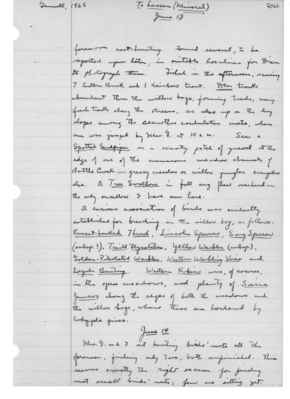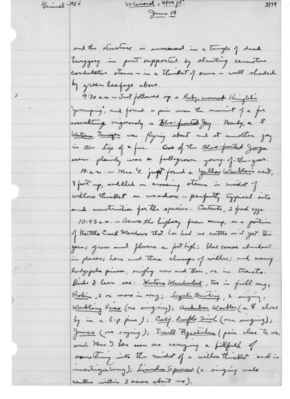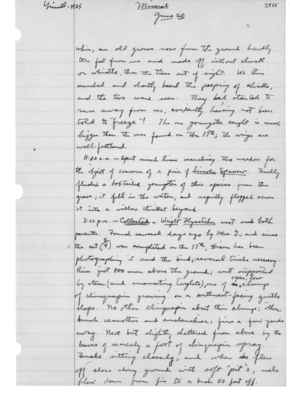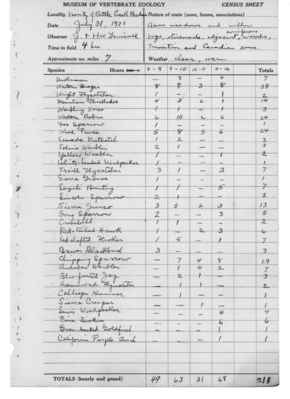Pages That Mention Lincoln Sparrow
1925: Joseph Grinnell's field notes
S2 Page 6
Collector: Grinnell - 1925 Location: Lassen Section (Mineral) Date: June 13-14, 1925 Page Number: 2462
forenoon nest-hunting. Found several, to be reported upon later, in suitable locations for Dixon to photograph them. Fished in the afternoon, securing 7 Eastern Brook and 1 Rainbow Trout. Deer tracks abundant thru the willow bogs, forming trails; many fresh tracks along the streams, as also up on the dry slopes among the Ceanothus cordulatus mats, where one was jumped by Mrs. G at 10 a.m. Saw a Spotted Sandpiper on a scanty patch of gravel at the edge of one of the numerous meadow channels of Battle Creek - grassy meadows on willow jungles everywhere else. A Tree Swallow in full song flew overhead - the only swallow I have seen here. A curious association of birds was evidently established for birding in the willow bog, as follows: Russet-backed Thrush, Lincoln Sparrow, Song Sparrow (subsp.?), Traill Flycatcher, Yellow Warbler (subsp.), Golden-Pileolated Warbler, Western Warbling Vireo and Lazuli Bunting. Western Robins were, of course, in the open meadows, and plenty of Sierra Juncos along the edges of both the meadows and the willow bogs, where these are bordered by lodgepole pines. June 14 Mrs. G. and I out hunting birds' nests all the forenoon, finding only two, both unfinished. This seems exactly the right season for finding most small birds' nests; few are sitting yet.
S2 Page 24
Collector: Grinnell-1925 Location: Mineral, 4800 ft. Date: June 19 Page Number: 2479
and the structure is ensconced in a tangle of dead twiggery in part supported by slanting ceanothus cordulatus stems - in a thicket of same - well shaded by green leafage above.
9:30 a.m. - Just followed a Ruby-crowned Kinglet's "yerruping," and found a pair upon the summit of a fir assaulting vigorously a Blue-fronted Jay. Nearby, a (female) Western Tanager was flying about and at another jay in the top of a fir. One of the Blue-fronted Jays seen plainly was a full-grown young-of-the-year.
10: a.m. - Mrs. G. just found a Yellow Warbler's nest, 8 feet up, saddled on crossing stems in midst of willow thicket on meadow - perfectly typical site and construction for the species. Contents, 2 fresh eggs.
10:45 a.m. - Across the highway from camp, on a portion of Battle Creek Meadows that has had no cattle on it yet this year; grass and flowers a foot high; blue camas abundant in places; here and there clumps of willow; and many lodgepole pines, singly now and then, or in tracts. Birds I hear are: Western Meadowlark, two in full song; Robin, 2 or more in song; Lazuli Bunting, 2 singing; Warbling Vireo (one singing); Audubon Warbler (a (female) close by in a l-p pine); Calif. Purple Finch (one singing); Junco (one singing); Traill Flycatcher (pair close to me, and Mrs. G has seen one carrying a billfull of something into the midst of a willow thicket and in investigating); Lincoln Sparrow (a singing male centers within 3 acres about us).
S2 Page 25
Author: Grinnell-1925 Location: Mineral, 4800 ft. Date: June 19 Page Number: 2480
Later: found the Traill Flycatcher's nest some 7 feet up in a crotch of slender willow stem in the midst of an isolated willow clump in the meadow - just in process of construction. In a tract of old lodge pole pines a little farther along, a crowd of birds was distraught over something, tho I failed to find what the threatening danger was. The crowd included: Juncos, a pair of Robins, a Lincoln Sparrow, a Pigmy Nuthatch (the first I have seen in the Lassen "section"), a Hammond (or Wright) Flycatcher, several Chipping Sparrows, and a pair of Audubon Warblers. Nearby was a (female) White-headed Woodpecker.
As to mammals: winter earthcores of Thomomys monticola occur in places where the ground is well-drained at the sides of meadows but not out in them. The common chipmunk is Eutamias amoenus, about logs overgrown with snowbushes, but they are very quiet now; two visit camp, but so far are shy. A (female) Eutamias senex was trapped in a neighbor's camp yesterday morning at 5 o'clock. Last evening just before sundown, Dixon shot an old male jack-rabbit (Lepus c. californicus) in a tract of sparse snowbush. Mrs. G. has seen another partly grown one in the same vicinity. This must be the extreme easternmost limit of this subspecies in the "section". Also, Mrs. G. and Dixon have both seen individuals of the snow-shoe rabbit (Lepus w. klamathensis).
S2 Page 30
Collector: Grinnell-1925 Location: Mineral Date: June 20 Page Number: 2485
whir, an old grouse rose from the ground hardly ten feet from us and made off without cluck or whistle, thru the trees out of sight. We then marched and shortly heard the peeping of chicks, and the two were seen. They had started to run away from us, evidently having not been told to "freeze"! The one youngster caught is much bigger than the ones found on the 17th; the wings are well-feathered.
11:30 a.m. - Spent much time searching the meadow for the object of concern of a pair of Lincoln Sparrow. Finally flushed a bobtailed youngster of this species from the grass; it fell in the water, and rapidly flopped across it into a willow thicket beyond.
3:00 p.m. - Collected a Wright Flycatcher nest and both parents. Found several days ago by Mrs. G, and since the set (2/4) was completed on the 17th, Dixon has been photographing it and the bird; several trials necessary. Rim just 800 mm. above the ground; nest supported by stem (and innovating twiglets), one of an ^open, low clump of chinquapin growing on a southwest-facing gentle slope. No other chinquapin about this clump; other brush ceanothus and amelanchier; firs a few yards away. Nest but slightly sheltered from above by the leaves of scarcely a foot of chinquapin spray. Female sitting closely, and when she flew off close along ground with soft "pit"s, male flew down from fir to a bush 50 feet off.
S2 Page 86
| MUSEUM OF VERTEBRATE ZOOLOGY | CENSUS SHEET |
| Locality: Vicinity of Battle Creek Meadows | Nature of Route(zone,fauna, associations): |
| Date: July 31, 1925 | Across meadows and willow |
| Observer: J. & H.W. Grinnell | bogs, streamside, adjacent ^coniferous woods; |
| Time in Field: 4 hrs. | Transition and Canadian zones |
| Approximate no. miles: 7 | Weather: clear, warm |
| Species Hours[arrow symbol pointing right] | 8-9 | 9-10 | 10-11 | 11-12 | Totals | |
| Unknown | - | 3 | - | 4 | 7 | |
| Western Tanager | 8 | 9 | 3 | 8 | 28 | |
| Wright Flycatcher | 1 | - | - | 1 | 2 | |
| Mountain Chickadee | 4 | 3 | 6 | 1 | 14 | |
| Warbling Vireo | 1 | 1 | 0 | 1 | 3 | |
| Western Robin | 6 | 10 | 2 | 6 | 24 | |
| Fox Sparrow | 1 | 0 | 0 | 0 | 1 | |
| Wood Pewee | 5 | 8 | 5 | 6 | 24 | |
| Canada Nuthatch | 1 | 2 | 0 | 0 | 3 |
TOTALS (hourly and grand)|49|63|31|68|211




